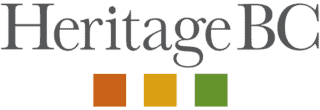- Heritage 101
- Advocacy
- Accessibility for Historic Places
- Climate & Sustainability
- Cultural Maps
- Heritage Place Conservation
- Heritage Policy & Legislation
- Homeowners
- Intangible Cultural Heritage
- Reconciliation
- Indigenous Cultural Heritage
- Setting the Bar: A Reconciliation Guide for Heritage
- 1. Heritage and Reconciliation Pledge
- 2. Acknowledging Land and People
- 3. Celebrating Days of Recognition and Commemoration
- 4. With a Commitment to Learn
- 5. Committing to Strategic Organizational Diversity
- 6. Mission-Making Room for Reconciliation
- 7. Possession, Interpretation, Repatriation and Cultural Care
- 8. Shared Decision Making
- 9. Statements of Significance and other heritage planning documents
- 10. Heritage Conservation Tools, Local Government Act
- Racism: Do Not Let the Forgetting Prevail
- Taking Action: resources for diversity and inclusion
- Webinars On-Demand
Community Heritage Register: Real Property
 According to the Local Government Act (LGA), a Community Heritage Register identifies “real property” that possesses heritage value and character. The term “real property” is not easily understood and this sometimes results in a restricted interpretation or a narrow implementation of a Community Heritage Register. The following examples illustrate that there is more breadth to the definition of “real property” than is sometimes understood.
According to the Local Government Act (LGA), a Community Heritage Register identifies “real property” that possesses heritage value and character. The term “real property” is not easily understood and this sometimes results in a restricted interpretation or a narrow implementation of a Community Heritage Register. The following examples illustrate that there is more breadth to the definition of “real property” than is sometimes understood.
The LGA includes a definition that reads: “real property includes buildings, structures and other improvements affixed to the land.”
The Community Charter offers this definition: “real property means land, with or without improvements so affixed to the land as to make them in fact and law a part of it.”
Real property is a subset of Canadian property law, which also includes personal property. The Canadian Encyclopedia addresses both types, “Real property (or realty) is land, any buildings on that land, any mineral rights under the land, and anything that is attached to the land or buildings that can be considered permanent. Personal property (sometimes known as chattels) includes any property that is not real property.” (source)
A University of Toronto resource guide says real property “refers to real estate or realty law, [and] deals with immovable property in the form of land, buildings, fixtures, etc.” (source)
The Province of British Columbia describes real property in a tax bulletin (source): “Real property is land and anything that is attached to the land so it becomes part of real property after installation (i.e. ceases to be personal property at common law). This would normally include buildings, structures, and things, such as machinery or equipment, that are attached to the land (or to buildings or structures) by some means other than their own weight.”
This bulletin also offers examples:
- Buildings and integral components of buildings or land, such as windows, doors, plumbing, electrical and heating systems
- Structures affixed to land, including concrete driveways and sidewalks
- Topsoil, sod, gravel and other materials that have been installed (e.g. spread) on real property
- Certain very large machinery or equipment that is constructed on site, such as machinery used in sawmills, pulp mills or other industrial locations, that is specifically excluded from the definition of affixed machinery.
While the bulletin was prepared for a specific purpose (provincial tax application by real property contractors), it nevertheless helps to provide further clarity.
Finally, the example of watercraft can provide further clarity. Based on the preceding information, a vessel cannot be considered real property if it is still in the water, as it is not fixed to the land and it is moveable. However, if the vessel is permanently dry-docked, and therefore immovable, it can be considered real property. Assuming the vessel meets other criteria, it is now eligible for heritage consideration according to the LGA.
This is, in fact, the case for the S.S. Moyie, which is on display on the shore of the Kootenay Lake and is included on the provincial and national registers.
In addition to many man-made structures, the BC Register of Historic Places includes other types of heritage resources, such as parks, watercraft, rivers, and trees. (The map of the BC Register of Historic Places can be found here.) Examples of recognized heritage assets that have met LGA requirements are:
Parks
- Piper Park, Nanaimo
- Dewdney Trail, Manning Park
- Sinclair Park, New Westminster
Vessels
- S. Naramata
- S. Sicamous
- S. Moyie
Natural Environment
- Tsolum River Garry Oak Ecosystem, an area that features over a hundred Garry oak trees as well as numerous species of mature trees and vegetation.
- Rock Tree, a native mature Western Red Cedar located in Surrey and growing out of a split glacial erratic boulder that is approximately two metres by three metres in size.
- Catalpa tree, estimated to be about 100 years old and included on Nanaimo’s list of heritage trees
Industrial Features
- The Ditch, a concrete canal in the southern Okanagan.
- Courtenay Riverway, which forms from its source at the confluence of the Puntledge and Tsolum Rivers and flows through the City of Courtenay before draining into Comox Bay
Please note, Heritage BC is not proposing a legal definition of the term “real property” or providing advice. Our aim is to support local governments in developing Community Heritage Registers and understanding the breadth of implementation. Local governments should seek legal advice as required.
